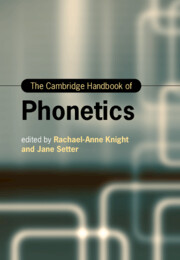Book contents
- The Cambridge Handbook of Phonetics
- Cambridge Handbooks in Language and Linguistics
- The Cambridge Handbook of Phonetics
- Copyright page
- Contents
- Figures
- Tables
- Contributors
- Introduction
- Section I Segmental Production
- Section II Prosodic Production
- Section III Measuring Speech
- Section IV Audition and Perception
- Section V Applications of Phonetics
- 20 Pedagogical Approaches
- 21 Pronunciation Teaching
- 22 Sociophonetics
- 23 Developmental Phonetics of Speech Production
- 24 Clinical Phonetics
- 25 Forensic Phonetics
- 26 The Phonetics of Talk in Interaction
- 27 The Phonetics/Phonology Interface
- Index
- References
21 - Pronunciation Teaching
from Section V - Applications of Phonetics
Published online by Cambridge University Press: 11 November 2021
- The Cambridge Handbook of Phonetics
- Cambridge Handbooks in Language and Linguistics
- The Cambridge Handbook of Phonetics
- Copyright page
- Contents
- Figures
- Tables
- Contributors
- Introduction
- Section I Segmental Production
- Section II Prosodic Production
- Section III Measuring Speech
- Section IV Audition and Perception
- Section V Applications of Phonetics
- 20 Pedagogical Approaches
- 21 Pronunciation Teaching
- 22 Sociophonetics
- 23 Developmental Phonetics of Speech Production
- 24 Clinical Phonetics
- 25 Forensic Phonetics
- 26 The Phonetics of Talk in Interaction
- 27 The Phonetics/Phonology Interface
- Index
- References
Summary
In this chapter, we review phonetics in pronunciation teaching and learning from a historical perspective, before going on to look at paradigms for pronunciation and second language (L2) phonology with a focus on phonetic issues. Research identifying the importance of access to phonetic cues, auditory and visual, both in experimental and classroom settings, is presented, demonstrating the increasing emphasis on technology in this field. We then move on to recommendations for teacher training, with a review of approaches to describing intonation for pedagogic purposes. Finally, we present suggestions for the future of pronunciation teaching and learning.
Keywords
- Type
- Chapter
- Information
- The Cambridge Handbook of Phonetics , pp. 527 - 550Publisher: Cambridge University PressPrint publication year: 2021



